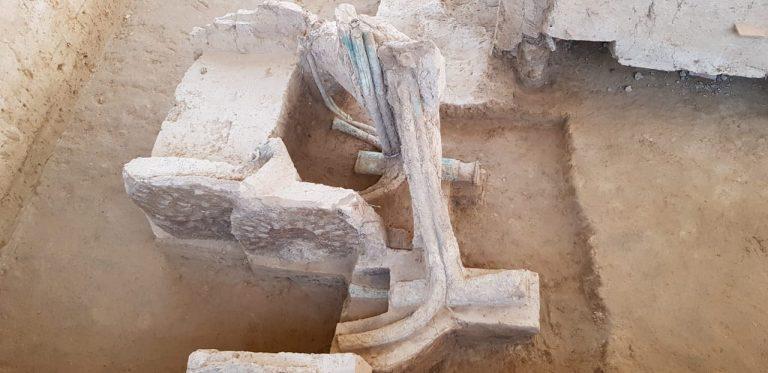
Ancient chariots along with eight well-preserved corpses have been discovered by Indian archaeologists in a village of Sanauli 70 kilometers north of New Delhi. The find has been dated to belong to the period 2000 – 1800 BCE and included chariot parts like wheels, axles and poles. The archaeological team proposed a connection with royalty and a warrior class for the findings.[6][7] Some scholars believe it to be very close to post Mahabharat period when a great war was fought in India involving every king and nation.
Sinauli is an archaeological site located in Barot tehsil, Baghpat district, Uttar Pradesh, India, where 125 graves belonging to Indus Valley Civilisation were found.[1] These graves are dated c. 2200–1800 BC. Sanauli, discovered in 2005,[2] is a fairly recent addition to the list of Indus Valley Civilisation sites in India.[3]
The site at Sinauli was accidentally discovered by people levelling agricultural land. The Archaeological Survey of India began excavations at the site during September 2005.[4]
Burials
As of 2007, the graves found are dated c. 2200–1800 BC.[5] and are 125 in number. These are all oriented in a north-south direction and most are identified as primary burials. Some of the burials are identified also as secondary and multiple burials and animal bones are also discovered next to human bones. The age group of buried starts from 1–2 years and includes all age groups and both male and female. Burial goods generally consisted of odd number of vases (3, 5, 7, 9, 11 etc.) placed near the head, with dish-on-stand usually placed below hip area as well as antenna swords, sheath of copper, terracotta figurines, gold and copper bangles, beads of semi-precious stones (two necklace of long barrel shape) etc.[4]
Remains of a burnt brick wall with a finished inner surface ran along the eastern side of the burial. A dish-on-stands and a violin shaped flat copper container having nearly 35 arrow head shaped copper pieces placed in a row are included in other important findings from Sanauli.[5]
A burial ground of this numbers should have been associated with a large habitation site, but so far such an habitation nearby has not been located.[5]
Dish-on-Stand
The survey found that dish-on-stand was usually placed below the hip area, but in some cases was placed near the head or feet. It was clearly an important part of burial goods. Its mushroom-shaped form has not found at any other archaeological sites. It was used as holding stand and in one case, held the head of a goat.[5]
(Source : Wikipedia)
You can read more about the news by
and [Click here ….]
and [Click here ….]
Source: http://hinducouncil.com.au/new/indian-archaeologists-discover-mahabharat-time-4000-year-old-chariots-weapons/





